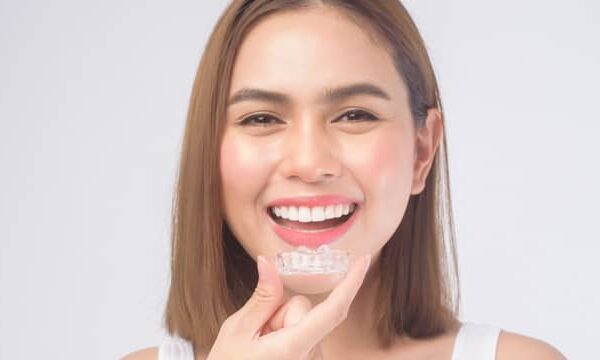In recent years, Invisalign® treatment has beena significant innovation in orthodontics to straighten teeth without metal braces. It’s certainly proven to be a popular option, but exactly how does Invisalign® work and will it deliver a good result? Let’s examine this question a bit closer.
What is Invisalign®?
Invisalign® is almost invisible orthodontic treatment that utilises removable aligners, also referred to as trays, to straighten teeth. Patients wear a series of clear plastic removable trays that fit over the teeth and work similarly to conventional braces by applying pressure to the teeth to guide them into alignment.
How does Invisalign® work?
Invisalign® corrects various bite issues, including overbite, crossbite, and underbite, closes gaps in the teeth and straightens out crowded teeth that are twisted or overlapping. An examination of the mouth and smile assessment is necessary to determine whether an individual is suitable for Invisalign® treatment. If so, we will discuss your treatment plan, costs and how long the treatment will take.
A digital scan is taken of the teeth using an iTero scanner that maps out a custom treatment plan and determines the number of clear aligners required to align the teeth. At this stage, patients can view their new smile, and the dentist can carry out any tweaks or alterations in real-time to ensure patients achieve their dream smile.
Each Invisalign® aligner must be worn for 22 hours a day for 1-2 weeks before being replaced with the next aligner in the series.
The aligners are custom-made and issued in batches, so there’s no need to visit the dentist as often as traditional braces that must be adjusted every month.
How long does Invisalign® Treatment take?
That depends on each specific case. The Invisalign® system is most suitable for mild to moderate cases and typically takes twelve to eighteen months. However, treatment can take as little as three months if only your front teeth require moving. To achieve the best results, it’s essential to wear clear aligners for the specified time each day and attend regular dental appointments to monitor your progress.
Do I have to wear retainers after Invisalign® treatment?
In a word, yes. It’s essential to wear retainers following treatment with clear aligners to prevent teeth from shifting back to their former positions and undoing your hard work. Retainers will probably need to be worn full-time initially and gradually reduced to nighttime only.
What are the benefits of Invisalign® treatment compared to traditional braces?
Discretion
These clear aligners are virtually invisible, and for anybody concerned with showing a mouthful of metal when they smile, they are an ideal option.
Comfort
All orthodontic treatments cause a certain amount of discomfort, which applies to aligners and traditional braces.
Just as the teeth and gums may feel tender for a few days when braces have been adjusted, inserting a new aligner will also have the same effect until your mouth becomes accustomed to the pressure applied.
However, traditional braces with metal brackets and wires are bulkier and more uncomfortable. They can also rub against the mouth’s soft tissues, causing soreness and lacerations. Invisalign® uses clear, smooth, medical-grade plastic that fits imperceptibly over the teeth and doesn’t cause lacerations to the delicate mouth tissues.
Removable
One of the most significant advantages of Invisalign® over traditional braces is that the aligners are removable. If you play contact sports, this could be a massive benefit as you won’t have to worry about damaging your braces (or your mouth) when you participate in your sporting activity.
Eat what you like
As aligners are removable, they don’t affect diet choices. Simply remove them when eating, and you can consume ribs, corn on the cob, apples, and other foods that should be avoided with traditional braces for fear of bending the wires or dislodging the brackets.
Maintain oral hygiene
One of the other main benefits of wearing removable aligners rather than fixed braces is the ease of maintaining a regular oral hygiene routine. You can remove your aligner every morning and evening to clean it and brush and floss your teeth simultaneously before placing it back over your teeth. Unlike with metal braces, there is no need to purchase additional products such as interdental brushes to clean behind the wires or a water flosser to remove trapped food particles and plaque.
Fewer visits to the dentist
As the aligners are given to you in batches, there is no need to visit the dentist as often as you would if you had traditional braces to get them adjusted. Additionally, with conventional braces, patients need to sit in the dental chair for ages while brackets and wires are affixed to their teeth at the beginning of treatment and removed at the end. With clear aligners, you simply pop them in and out yourself.
How does Invisalign® work? The takeaway
For your Invisalign® treatment to work, you must comply with the instructions from the dentist and be sure to wear your aligners for 20-22 hours a day. Failure to do so can impact treatment, and you may require more aligners and need to spend even more on your orthodontic treatment.
Do you want to straighten your teeth?
Invisalign® may not be for everyone, but if you’re keen to straighten teeth discreetly and hassle-free, it might be an excellent choice for you.
Why not schedule an appointment with our experienced Invisalign® dentists? Get in touch today.
References
Medical News Today – How Can Orthodontic Treatment Help?
https://www.medicalnewstoday.com/articles/249482
Healthline.com – What Types of Dental Issues Can Invisalign® Correct
https://www.healthline.com/health/does-invisalign-work#how-it-helps
Colgate.com – Retainers for Teeth – What Are They And Why Wear Them?
https://www.colgate.com/en-us/oral-health/adult-orthodontics/retainers-for-teeth-why-wear-them-and-how-to-keep-them-safe



